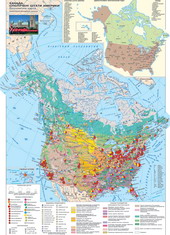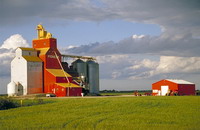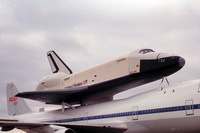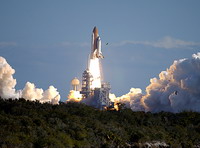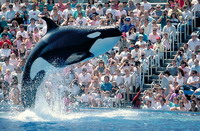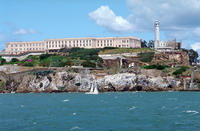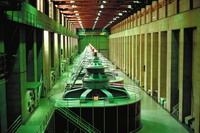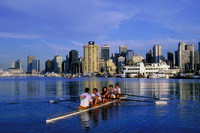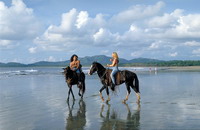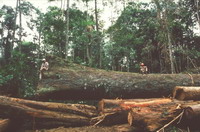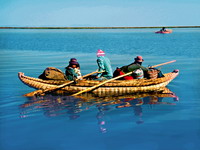On this map shows the region North America ( Anglo-America ). Related to this region except the U.S., Canada, the three dependent territories: Greenland (Denmark), Bermuda (UK) Saint Pierre and Miquelon (France). Shown separately Hawaii (50 th U.S. state), located in the Pacific Ocean by 4000 km from the western U.S. coast.
Anglo-America is one of the main economic and political centers in the world. It played a leading role most powerful country in the world USA and one of the leading industrialized nations - Canada. Both countries are members of the Group of Seven . Their economy is closely integrated with each other.
USA - highly developed postindustrial countries. Almost 70% of the country are busy working in non-production sphere. In the U.S. accounted for a quarter of world industrial production. Of particular importance are the newest intensive production: precision engineering and transport, chemical industry, nonferrous metallurgy, electric power. Traditionally, still play an important textile and food industries.
USDA - of high and diversified. It satisfies the internal needs of the country in food and raw materials and provides a significant portion of export earnings. The main component of agriculture is the farm, which is typical for a high level of technical and scientific support and as a result, high productivity.
across the country observed a clear zonal specialization of agriculture. It includes the following agricultural zones:
· wheat - from Canada to Texas;
· corn - the central plains;
· cotton - the Mississippi River Valley;
· Dairy - Pryozer'ya states;
· zone grazing beef cattle - West Mountain States;
largest area of vegetable production and horticulture are California, which provides half the world's third collection and lemons - oranges. In the Central Plains of soybeans and sunflowers are grown in Florida and Hawaii - sugar cane in pryatlantychnomu coast - tobacco, peanuts, cotton.
territorial structure in the U.S. traced some differences. North of the country (industrial North) produces more than half of various industrial and agricultural products. The largest centers - Chicago, Detroit, New York, Philadelphia. It contains about half the population (megalopolis Pryatlantychnyy BosVash - 50 million people and lakeside ChyPits - 35 million people).
South specializes in mining, chemical and textile industries, as well as certain sectors of agriculture. On the coast of the Gulf of Mexico formed the world's largest oil and gas complex (Texas, Louisiana, Oklahoma).
western portion is an area of later development, but the pace of development ahead of others. It is dominated by extractive industries, forestry, sheep breeding and tourism. Los Angeles called air raketokosmichnoyu capital, there is also the film industry center Holliwood . Las Vegas - the center of gambling and entertainment. From San Francisco to San Diego California megalopolis stretching San San, with a population of 25 million people.
Modern American economy characterized by high concentration of production and capital. The largest U.S. companies by their nature, are transnational ( General Motors, General Electric, Boeing, IBM, Microsoft and others). The state promotes the development of the latest high-tech industries, finance promising research, especially in the military-industrial complex and related fields.
Canada occupies the northern part of the mainland. In size, the country second only to Russia. Canada is part of the British Commonwealth of Nations and formal head of state here is the Queen who appoints the governor general on the recommendation of the Prime Minister of the state. Canada - federal country where the president performs the duties of prime minister.
as rich natural resources of Canada is among the highest in the world.
Canada is a country of migration of capitalism, its development took place while maintaining political dependence on the metropolis, under the influence of European and later American capital. An important feature of modern economics associated with colonial heritage remains a primary export-oriented economy and dependence on foreign capital. Over 50% of the national economy controlled by foreign capital, about
in placing the economy is characterized by high territorial concentration in the south, to a lesser extent - in the central provinces of Ontario and Quebec. There is a all in manufacturing industry and the areas of mineral extraction. Major industrial centers - Montreal, Toronto. Northern Territory are under development. In areas with extreme conditions of life are mined some minerals and common traditional occupation of the local population (zvirobiynyy sea fishing, fishing, hunting deer and fur animals). Prairie provinces (Saskatchewan, Manitoba, Alberta) is a major agricultural area. They specialize in grain farming, beef cattle, sheep. Canada also grows sugar beets and an exporter of wheat and barley.
In 1999 UN Canada recognized the most attractive country for life. This estimate is primarily linked with the level of social security, insurance system, different privileges, conditions of life and recreation and more. Achievement of Canada in this area are known worldwide.
 English
English
